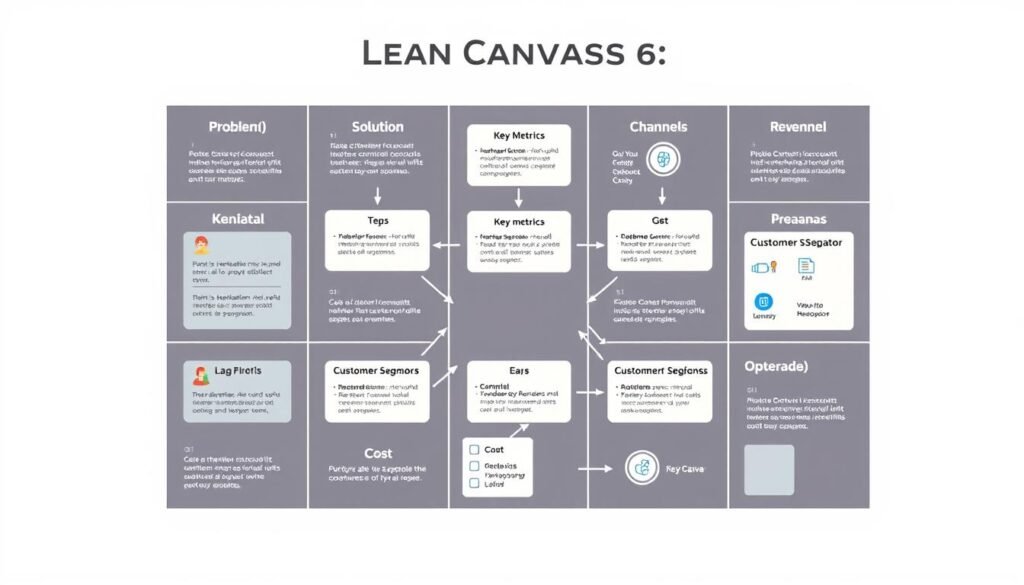Understanding the Lean Canvas Model for Startups

Startups face a big challenge: turning ideas into successful businesses. The Lean Canvas Model helps entrepreneurs tackle this task. It’s a tool that focuses on solving problems and meeting customer needs.
Ash Maurya created this model to help startups validate their ideas. It’s based on the Business Model Canvas but tailored for new ventures. The Lean Canvas helps identify key challenges and build strategies for success.
Key Takeaways
- The Lean Canvas Model is a one-page business planning tool designed for startups to validate their ideas and create successful strategies.
- It is an adaptation of the Business Model Canvas, with a focus on problem-solving and customer-centric approaches.
- The Lean Canvas comprises nine key building blocks, including problem, solution, unique value proposition, and more.
- The Lean Canvas model encourages stakeholder participation and streamlines the process of defining a business model.
- Using the Lean Canvas can help startups simplify their business planning, foster team collaboration, and maintain a strong focus on customer needs.
What is the Lean Canvas Model?
The Lean Canvas Model is a strategic planning tool for startups. It breaks down business ideas into key components. This one-page format helps entrepreneurs identify risky assumptions and brainstorm business models.
Ash Maurya created this tool, inspired by the lean startup methodology. It offers a quick way for entrepreneurs to communicate their ideas effectively.
Definition and Purpose
The Lean Canvas Model focuses on problem-solution fit and customer-centric approaches. It helps startups quickly validate their ideas. This tool encourages adapting business planning based on real learning, not assumptions.
History and Development
The Lean Canvas Model evolved from the Business Model Canvas. It’s tailored for startups and startup tools. This model simplifies business planning and promotes quick iteration.
Entrepreneurs can use it to launch their ventures efficiently. It’s a valuable resource for those starting new businesses.
Key Features
- Focuses on the problem-solution fit
- Adopts a customer-centric approach
- Facilitates rapid iteration and adaptation
- Encourages the identification and mitigation of key risks
- Provides a concise, one-page format for business planning
The Lean Canvas Model helps startups outline their ideas quickly. It identifies critical assumptions and tests hypotheses efficiently. This approach aligns with lean startup methodology principles.
Entrepreneurs can make data-driven decisions using this model. It allows them to pivot strategies as needed.
Components of the Lean Canvas
The Lean Canvas is a quick business model tool for startups. It helps validate ideas fast. The canvas has nine key blocks that shape a company’s strategy.
Problem Statement
First, identify top problems your target customer segments face. This forms the base of your business model. It ensures your solution meets real customer needs.
Proposed Solution
Next, outline your product’s features that solve customer problems. Your solution should offer unique value. It must stand out from competitors.
Unique Value Proposition
The Unique Value Proposition (UVP) is crucial. It explains why customers should pick your product. A strong UVP highlights key metrics and revenue streams.
These elements help deliver great value to customer segments. They set your business apart in the market.
| Component | Description |
|---|---|
| Problem Statement | Identify the top problems that the target customer segments are facing |
| Proposed Solution | Outline the features and functionalities of the product or service that aim to solve the identified customer problems |
| Unique Value Proposition | Explain why customers should choose the product or service over alternatives, highlighting the key metrics and revenue streams the business will focus on |

“The Lean Canvas is a powerful tool that helps entrepreneurs distill their business ideas into a concise, actionable plan. By focusing on the problem, solution, and unique value proposition, startups can quickly validate their concepts and iterate towards product-market fit.”
Benefits of Using the Lean Canvas
The Lean Canvas model offers key advantages for startups and entrepreneurs. It simplifies business planning and boosts team collaboration. The model also sharpens focus on customer development and business model validation.
This tool empowers innovators to tackle startup challenges more effectively. It helps them navigate the complex world of new businesses with greater ease.
Simplification of Business Planning
The Lean Canvas provides a concise, visual format for business ideas. It captures essential aspects without lengthy plans. This streamlined approach helps entrepreneurs focus on core elements of their startup methodology.
Fostering Team Collaboration
The Lean Canvas encourages team participation and idea sharing. It creates a collaborative environment for different perspectives. This leads to a more robust business model validation.
Improved Focus on Customer Needs
The Lean Canvas emphasizes problem-solution fit and customer understanding. It helps entrepreneurs address real customer needs and pain points. This focus increases the chances of market success.
The Lean Canvas simplifies planning, promotes teamwork, and keeps startups customer-focused. These benefits make it a powerful tool for entrepreneurs. It guides them through startup methodology and business model validation effectively.
| Benefit | Description |
|---|---|
| Simplification of Business Planning | The Lean Canvas provides a concise, visual format that captures the essential aspects of a business idea, helping entrepreneurs avoid getting bogged down in lengthy business plans. |
| Fostering Team Collaboration | The Lean Canvas encourages participation and idea sharing within the startup team, leading to a more robust business model validation. |
| Improved Focus on Customer Needs | The Lean Canvas emphasizes problem-solution fit and understanding the target customer, increasing the likelihood of market success. |
How to Create Your Own Lean Canvas
A clear business plan is crucial for startup success. The Lean Canvas model offers an efficient framework for entrepreneurs. It helps break down ideas and identify key elements for their venture.
Startups can use the Lean Canvas to streamline planning. This approach helps prioritize critical aspects of the business. It’s a powerful tool for focused and effective startup development.
Identifying Essential Elements
The Lean Canvas is a one-page template with nine key components. These include the problem, customer segments, and unique value proposition. It also covers the proposed solution, channels, and revenue streams.
Other elements are cost structure, key metrics, and unfair advantage. Focusing on these helps startups understand their business model better. It provides a clear picture of the venture’s core aspects.
Step-by-Step Instruction
- Define the problem you are aiming to solve.
- Identify your target customer segments.
- Craft a compelling unique value proposition that sets your business apart.
- Outline the proposed solution to the problem.
- Determine the distribution channels to reach your customers.
- Establish the key revenue streams that will generate income.
- List the major cost components of your business.
- Define the key metrics that will measure the success of your venture.
- Identify your unfair advantage – the unique asset or capability that competitors cannot easily replicate.
Tips for Effective Use
- Focus on the core issues and be concise in your Lean Canvas.
- Regularly update the canvas based on new insights and customer feedback.
- Emphasize the minimum viable product (MVP) and gradually expand your offering.
- Use the Lean Canvas to foster collaboration within your team and align on the business priorities.
This structured approach creates a solid foundation for business planning. The Lean Canvas provides a comprehensive overview of your startup. Its flexibility allows for quick updates as market conditions change.
Regular revisions keep your startup agile and responsive. This model helps teams stay focused on key priorities. It’s an invaluable tool for navigating the dynamic startup landscape.

Common Mistakes to Avoid
The Lean Canvas model is powerful for product development and customer validation. However, entrepreneurs often make mistakes that reduce its effectiveness. Let’s explore three key pitfalls to avoid.
These mistakes include overcomplicating the canvas, ignoring customer feedback, and failing to update the model. By steering clear of these errors, you can maximize the benefits of the Lean Canvas.
Avoiding Overcomplicated Lean Canvases
The Lean Canvas shines in its simplicity and focus on essential business elements. Some entrepreneurs overload it with too much information. This can hide the core components that should guide decision-making.
To harness the Lean Canvas’s power, resist adding unnecessary details. Instead, concentrate on key aspects that matter for your product development and customer validation.
Prioritizing Customer Feedback
Ignoring customer feedback is a common mistake. The Lean Canvas helps you understand your target audience deeply. This requires active listening to their needs, pains, and preferences.
Entrepreneurs who overlook customer insights miss chances to improve their business models. By valuing feedback, you can better serve your audience and refine your pivot strategies.
Embracing Continuous Iteration
Many startups treat the Lean Canvas as a static document. This is a mistake. Successful entrepreneurs see it as a living, evolving tool.
Regularly update your canvas as you gain knowledge, face challenges, or spot market trends. This keeps your business agile and responsive, setting the stage for long-term growth.
“Continuous iteration unlocks the true power of the Lean Canvas. View it as a dynamic tool for product development and customer validation. This opens doors to greater innovation and adaptability.”
Avoid these pitfalls and embrace the Lean Canvas as a flexible, customer-focused framework. This approach positions startups for lasting success in today’s fast-changing business world.
Real-World Applications of the Lean Canvas
The Lean Canvas model has helped many startups succeed. It focuses on solving problems and innovating business models. This agile framework helps entrepreneurs test ideas and find product-market fit.
Let’s look at how some successful startups used the Lean Canvas. These companies grew by applying its principles.
Successful Startups Using Lean Canvas
Tech giants like Facebook, Google, and Apple used Lean Canvas early on. Facebook, started in 2004, had $104 billion funding at IPO. Google, founded in 1998, had $23.1 billion in funding.
Apple, founded in 1976, had $6.2 billion in funding. Newer companies also embraced Lean Canvas. Tesla (2003) raised $19.9 billion, while Skype (2003) got $76.8 million.
Lessons Learned from Implementations
- Lean Canvas stresses understanding customer problems and testing solutions through experiments and feedback.
- Startups using Lean Canvas focus on key metrics like Activation and Retention. They aim for a healthy LTV/CAC ratio of 3:1 or higher.
- The model promotes flexibility and quick changes. Startups can adapt their business models based on market feedback and customer needs.
These startups overcame challenges and grew using Lean Canvas principles. It’s a valuable tool for startup success stories, business model innovation, and lean startup examples.
Conclusion: Embracing the Lean Canvas Model
The Lean Canvas Model helps startups visualize and refine their business ideas. It focuses on problem-solution fit and customer-centricity. This framework empowers entrepreneurs to navigate startup growth with agility.
Recap of Key Insights
Key insights include identifying customer problems and crafting a unique value proposition. Leveraging AI-driven analytics uncovers market trends and preferences. The model’s simplicity and lean principles make it valuable for startups.
It emphasizes value creation, continuous improvement, and respect for people. These aspects help startups achieve sustainable success.
Encouragement for Startups
Startups should use the Lean Canvas Model as a growth tool. Adopting an entrepreneurial mindset focused on learning and adaptation is crucial. This approach helps entrepreneurs position their ventures for long-term success.
The model aligns business strategies with customer needs. It sets the stage for startups to thrive and make an impact.
Final Thoughts on Iteration and Growth
The Lean Canvas Model guides startups through business challenges and opportunities. It helps entrepreneurs foster innovation, adaptability, and sustainable growth. These are key to success in today’s dynamic business world.
By embracing startup growth, business model canvas, and an entrepreneurial mindset, startups can thrive. This approach leads to long-term success in our ever-changing business landscape.
FAQ
What is the Lean Canvas Model?
The Lean Canvas Model is a one-page business plan tool. It helps entrepreneurs test ideas and find key challenges. This model adapts the Business Model Canvas, focusing on solving problems and putting customers first.
What are the key features of the Lean Canvas Model?
The Lean Canvas Model focuses on problem-solution fit and customer needs. It allows quick changes based on real-world learning. The model has nine building blocks guiding entrepreneurs from idea to success.
What are the components of the Lean Canvas?
The Lean Canvas has nine key parts. These include Problem, Customer Segments, and Unique Value Proposition. It also covers Solution, Channels, Revenue Streams, and Cost Structure. Lastly, it includes Key Metrics and Unfair Advantage.
What are the benefits of using the Lean Canvas?
The Lean Canvas saves time and reduces waste. It allows quick testing of business ideas. The model improves teamwork and focuses on customer needs.
How do I create a Lean Canvas?
To create a Lean Canvas, start by identifying your business idea’s key elements. Define the problem and identify customer segments. Craft a unique value proposition and outline the solution.
Next, determine channels and establish revenue streams. List costs and define key metrics. Finally, identify your unfair advantage.
What are common mistakes to avoid when using the Lean Canvas?
Avoid adding too many details to your Lean Canvas. Don’t ignore customer feedback in favor of your own assumptions. Remember to update your canvas as you learn new information.
How have successful startups used the Lean Canvas?
Many successful startups have used the Lean Canvas to test their business models. Case studies show how it’s been used across various industries. These examples highlight the importance of customer feedback and quick changes.





